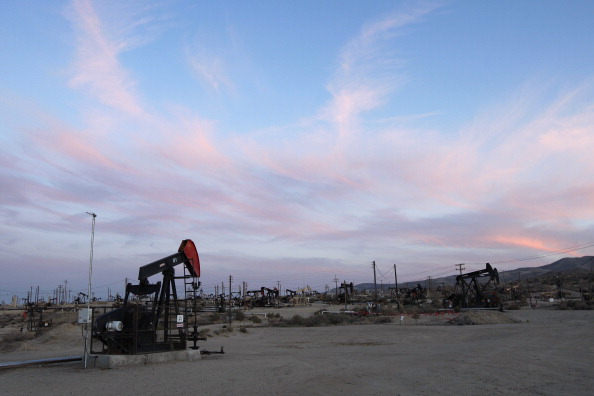Let’s make a couple of points with the juxtaposition of the newest U.S. report on energy production on federal lands and a pair of new analyses people are talking about this week.
First, there’s this piece by the Manhattan Institute’s Jared Meyer on the Real Clear Energy website, asserting that surging U.S. crude oil production is playing a big role in keeping global crude prices stable despite turmoil around the world:
The most important contribution to oil’s price stability has been the substantial increase in U.S. production. U.S. crude oil production has risen 50 percent since 2008, to 7,443 thousand barrels a day. This increase has been driven by advances in drilling technology. Hydraulic fracturing has opened up previously-known reserves that were either inaccessible or too cost-prohibitive for drilling.
Meyer quotes Ben Montalbano, director of research and operations for the Energy Policy Research Foundation:
“Without the increase in U.S. oil production over the past few years, OPEC’s excess capacity would be at or near zero. We lost 1 million barrels from Libya, and another 1 to 1.5 million barrel due to Iranian sanctions. Oil prices would likely be $20 to $40 dollars per barrel higher than they are now.”
Then there’s this on Fuel Fix.com, detailing a new Deloitte study that suggests U.S. production is starting to lessen OPEC’s command of international oil markets:
The shale bonanza already has proven it can sway international markets, by stabilizing prices as the Organization of Petroleum Exporting Countries’ spare capacity tightened and Middle Eastern conflicts disrupted global supplies, according to Deloitte’s annual Oil and Gas Reality Check report released this week. “As the U.S. becomes more self-sufficient, it’s possible to see the U.S. interest in the Middle East wane, and the extent to which the Middle East feels they have sway over the U.S. will decline because it’s less dependent” on oil imports, said Carl Hughes, Deloitte’s global industry leader for energy and resources, in an interview with FuelFix this week.
Bottom line: Increased U.S. oil production – the International Energy Agency projects we’ll pass Saudi Arabia and Russia as the world’s No. 1 producer next year – is a good thing for America, stabilizing global crude markets and helping to shield the U.S. against crude price shocks caused by world crises. It’s a compelling argument for energy strategies and policies that sustain and grow domestic oil and natural gas development, including greater access to domestic oil and gas reserves.
Here’s the juxtaposition part: A new report by the U.S. Energy Information Administration (EIA) shows continued decline in oil and natural gas production on federal lands, as measured by energy sales from those lands. Important details:
- While sales from crude oil production on federal areas (onshore and offshore) ticked up 1 percent in 2013, the figure is more than 10 percent below what it was in 2003. Since 2010, sales from oil production on federal lands are down 16 percent.
- Sales from natural gas production on federal areas are down more than 43 percent since 2003, 24 percent since 2010.
EIA’s chart (which also shows sales from coal production):

And another EIA chart that shows the falloff in sale from oil produced in the Gulf of Mexico (left-hand columns), from which most federal production comes:

What’s apparent is the decline on federal lands since 2010. In the second chart you can see a spike in the Gulf that year, then a retreat. This indicates Gulf energy activity hasn’t recovered since the federal government’s six-month moratorium on deepwater drilling after the Macondo incident, followed by months of slow-paced deepwater permitting. While there have been new lease auctions for Gulf drilling, the federal government hasn’t opened new areas for development – for example, in the Eastern Gulf or on the Atlantic outer continental shelf. To that point, EIA notes declining natural gas production in the Gulf from “existing fields” that have matured in their output.
The conclusion is simple: To keep the U.S. energy revolution going strong, America needs increased access to oil and natural gas reserves – including the federal offshore, where 87 percent of the acreage under Washington’s control is off limits to development – and sound regulatory and permitting policies that ensure consistency and reasonable certainty for those making energy investments.
That’s the right path to more domestic energy, job creation and harnessing our energy wealth to give America greater influence on global markets while strengthening U.S. energy security. API senior advisor Andy Radford, during a recent conference call discussing offshore development:
“This energy renaissance has put millions of Americans to work, generated billions of dollars in revenue for the government, and put downward pressure on prices for consumers. But earlier this month, the International Energy Agency reported that we could fall behind OPEC countries if U.S. production plateaus, which IEA says could result in ‘tighter and more volatile oil markets’ and add $15 per barrel to the price of oil. … The U.S. has an unprecedented opportunity to be the global leader in energy for decades to come, but achieving our true potential will take leadership and foresight from those in government who hold the key to accessing our offshore energy reserves. The time has come to open the lock and allow safe and responsible energy production throughout the U.S. Outer Continental Shelf.”
By Mark Green
Originally Posted June 20, 2014
Energy Tomorrow is brought to you by the American Petroleum Institute (API), which is the only national trade association that represents all aspects of America’s oil and natural gas industry. Our more than 500 corporate members, from the largest major oil company to the smallest of independents, come from all segments of the industry. They are producers, refiners, suppliers, pipeline operators and marine transporters, as well as service and supply companies that support all segments of the industry.

